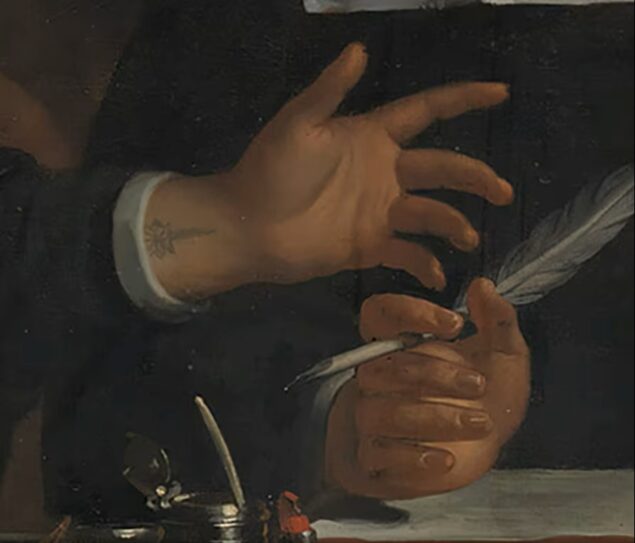During an inspection of a seventeenth-century painting in the Amsterdam Museum collection, a tattoo was discovered on the wrist of a prominent Amsterdam merchant. The painting, a 1674 portrait of the College of the Chief Commissioners of the Wharves attributed to Wallerant Vaillant (1623–1677), was undergoing a routine condition check when restorer Liesbeth Abraham noticed the mark on the inside of one subject’s wrist. It appears to be the earliest known depiction of a tattoo in Western European painting.
Inland ports
The painting portays the Chief Commissioners of the Wharves, who supervised the management of the city’s ports, wharves, and cranes. Amsterdam had old and new wharves, inland ports bordering the IJ that served as mooring places for ships. The council was part of the city administration and played a crucial role in Amsterdam’s logistics, trade, and infrastructure from the seventeenth century onwards. The painting shows four chief commissioners, the harbor master, his servant, and the captain of the ‘waalridders’, with a view of the harbor behind them. One of the four gentlemen shows the inside of his wrist; as his sleeve creeps up, a very special element becomes visible: a tattoo, in the center of the composition.

Attributed to Wallerant Vaillant (1623-1677), The Chief Commissioners of the Wharves, 1674, Amsterdam Museum
Tattoos ‘not done’
“There are no known visual or written sources from seventeenth-century Amsterdam that explicitly describe or depict tattoos. That makes the tattoo on the wrist of this Amsterdam gentleman such a special find,” says Judith van Gent, head of collections and research at the Amsterdam Museum. “Moreover, tattoos were still ‘not done’ for the citizens of seventeenth-century Amsterdam; they were associated with sailors, criminals, or outsiders.”
The man with the tattoo has been identified as Wessel Smits, a wealthy merchant born around 1618/19. According to Van Gent’s research, Smits moved in intellectual and literary circles through his stepfather Philibert Vernatti. He was acquainted with the poet Jacob Cats and the physicist Isaac Beeckman, among others. Van Gent found this to be a clue to the possible meaning of Smits’ tattoo.

Attributed to Wallerant Vaillant (1623-1677), The Chief Commissioners of the Wharves (detail), 1674, Amsterdam Museum
Special birth constellation
Not a flower, not a compass rose, but most likely a tailed star or comet: that is what adorns Smits’ wrist. In the seventeenth century, a comet was visible in Western Europe in 1618: the period when Wessel Smits was born. Some saw this cosmic phenomenon as a sign of God’s wrath. “It is quite possible that Smits saw the comet in line with his moment of birth,” says Van Gent. “Perhaps his stepfather Vernatti pointed out to Smits in his youth that he was born under a rare star constellation. In any case, he attached so much importance to it that he wanted to have himself portrayed with it.”
Further research
The Amsterdam Museum is continuing its research into this tattoo image. “Where and when Smits had the tattoo done, for example, is not yet known,” explains Van Gent. “It is possible that Smits gained experience traveling abroad with his stepfather and had the tattoo done there, but this requires further investigation.”
From 25 November 2025 to 1 March 2026, Vaillant’s painting will be on display in a small exhibition at Huis Willet-Holthuysen in Amsterdam.

